Too original tanks often lose ...
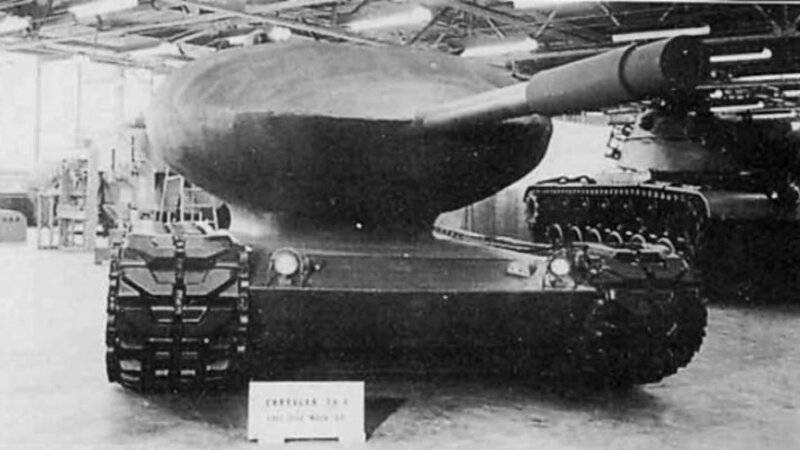
TV8 - "atomic tank" by Chrysler. Layout
A. P. Kazantsev "The Burning Island"
History armored vehicles. Originality is what very often people value above all else. However, in technology, originality alone will not go far. There are also such indicators as reliability, safety, efficiency, and such a very important economic indicator as ... price! This is especially true of military equipment, where effective but unreliable weapon it simply will not be able to perform the proper functions, and an effective, but too expensive one, will not become widespread, which means that it will not be effective again. And the best example of such a situation, which should be taken into account by all designers of military equipment and weapons, is the history of American nuclear tanks.
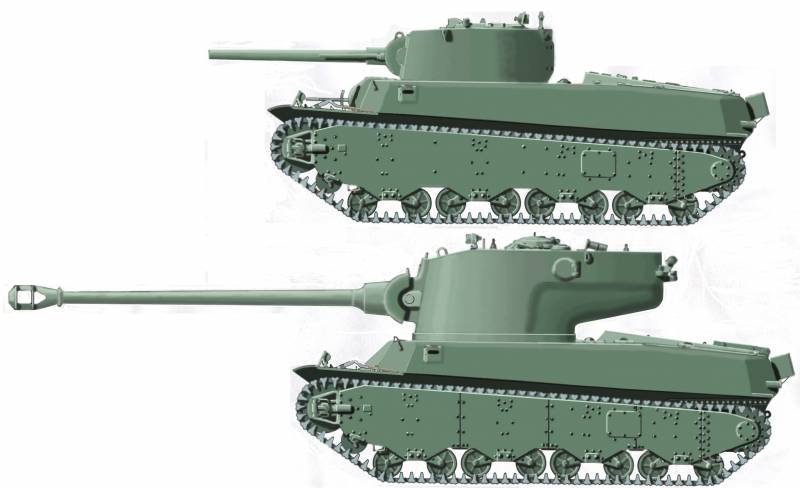
Back during the Second World War, American engineers created an impressive number of experienced tanks of various types, gradually improving them. In this drawing by a modern artist, we see a heavy tank M6 (above) and one of its subsequent modifications - the M6A2E1 tank
And it so happened that in the 50s of the last century, mankind got its hands on a new powerful source of energy - nuclear decay, and began to develop it in the most active way. It was then that nuclear power was seen as almost a means of solving all energy problems. It was proposed to put nuclear reactors not only on ships and submarines, but also on railway locomotives, airplanes, and even ... on cars. Science fiction writers enthusiastically described atomic airplanes, and atomic cars, not to mention atomic bullets. Naturally, the military also read all these novels and simply could not stay away from the passion for such projects. In particular, in the United States of America, they began to seriously consider projects to create a tank with a nuclear reactor as a power plant. Fortunately, all these projects remained so on paper, because the experience of their application showed that it justifies itself only on ships and submarines.
Well, the actual history of American "atomic tanks" began in June 1954 during the third scientific conference Question Mark, at which American scientists first considered the project of a tank with a nuclear reactor. Tank TV1 (Track Vehicle 1 - "Tracked vehicle-1") was supposed to have a mass of about 70 tons and a 105-mm rifled gun, and the layout of the tank was very original. So, a small-sized nuclear reactor was supposed to be located in the front of the tank behind 350 mm thick armor. Behind the reactor and biosecurity was the workplace of the driver and two machine gunners in individual rotating turrets, and behind it was a fighting compartment with a gun turret and another machine-gun turret on the roof. Behind the tower were the power plant units. The undercarriage of the tank had eight rollers on each side.
For simplicity of the device, the reactor for TV1 had to work with an open coolant circuit. That is, it was planned to cool the reactor with atmospheric air, which was supposed to heat up from it and rotate the gas turbine, which, in turn, would drive the tank's transmission and its driving wheels. Such a facility could operate for 500 hours on a single nuclear fuel station. Only during these same 500 hours of operation, a reactor with such a cooling system would infect several tens or hundreds of thousands of cubic meters of air passed through it with radiation. Therefore, such a cooling system was found unsuitable. In addition, due to the need to have sufficient biological protection of the reactor on the tank, it was not possible to fit it into the required dimensions. In general, TV1, if built, would have turned out to be more dangerous for its own troops than for the enemy's troops.
In 1955, the next Question Mark IV conference was held, at which an improved design of the atomic tank, called the R32, was presented. The new one was smaller, as the development of nuclear technology made it possible to improve the reactor and reduce its size. Now the tank weighed 50 tons, had a frontal armor plate thickness of 120 mm and a turret with a 90-mm gun. It was decided to abandon the gas turbine operating on overheated atmospheric air and use more modern and effective means of protecting the crew from radiation. Calculations showed that the cruising range at one refueling with nuclear fuel could be about four thousand kilometers. That is, a tank of this type would actually not need tankers.
The R32 was also safer than its predecessor TV1, but still, due to the high level of radiation, it was not suitable for practical use. It turned out that for one tank it would be necessary to have several replacement crews and change them every time as soon as the tankers "grab X-rays."
All these difficulties led to the fact that the military's interest in atomic tanks began to gradually subside. True, back in 1959, a nuclear tank was designed on the basis of the M103 heavy tank. A draft design was prepared, and that was the end of it.
The latest project of a tank with a nuclear reactor was prepared by the Chrysler company, and not only prepared, but also made its full-size model. The new tank received the designation TV8 and was completely unique in all respects. There was nothing unusual about the tracked undercarriage, which cannot be said about the turret.
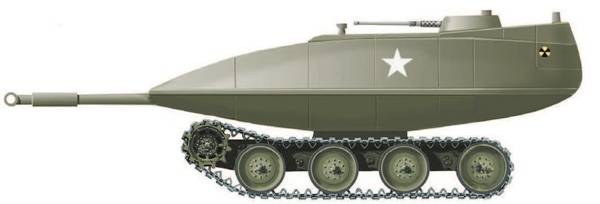
Tank TV8. Side view. The design of the tower is, of course, impressive ... Thanks to this shape, he could also float. But I couldn't shoot afloat!
The turret on this tank had a streamlined, faceted shape and for the first time in the history of world tank building was longer than the chassis itself. Everything was located inside it: the workplaces of the four crew members, the breech of the 90-mm recoilless system gun, and the ammunition load. Well, in the aft part of the tower there should have been a diesel engine or even a small-sized nuclear reactor. The reactor or engine was supposed to turn the generator, and that one would generate an electric current that powers the propeller motors and all the equipment of the tank. They argued only about where it would be best to place the reactor: in the tower or in the hull.
The TV8 mock-up was made, but it never went beyond the mock-up. The layout of this tank was too original, which was technically complex, but did not give any special advantages over both existing and developed tanks. Although, of course, this tank looked impressive and most of all resembled cars from science fiction films about the invasion of evil aliens.
Well, after the impressive TV8, not a single American atomic tank project came out even from the technical proposal stage. In other countries, replacing a diesel engine with a nuclear reactor was also considered, but even there it was recognized as technically unfeasible. Two features of nuclear power plants prevented their installation on a tank. Firstly, a reactor suitable for operation on a tank could not have sufficient anti-radiation protection. That is, his crew would be exposed to constant radiation. Secondly, in the event of damage to the tank and its power plant - and in a combat situation the likelihood of such an unpleasant development of events is very high - it turned into an extremely dangerous object for those around it. The chances of the crew to survive in this situation were very small, not to mention the fact that even those who survived would then have to be treated for radiation sickness.
It turned out that there was only one benefit from the use of an atomic reactor on a tank: an extremely large cruising range. But it did not cover all the other shortcomings of this design. Therefore, atomic-powered tanks in metal were not created and remained in the history of technology as an original technical idea that arose at the peak of a kind of fashion for everything atomic and nothing more.
In the tank "Hunter" ("Hunter"), developed by order of the US government in 1953-1955, everything was just as unusual - from the layout to the weapons and the chassis. The tank had a low silhouette and multi-layer armor with silicon dioxide as a filler, which provided high resistance to cumulative shells. At the same time, the mass of the tank should not exceed 40-45 tons. At that time, research on improving protection against cumulative ammunition was very widespread, and one of the solutions was just such a "glass" armor. With a thickness of 165 mm, it provided the same protection as monolithic armor of this thickness, but weighed significantly less.
The design of the upper part of the tank was very original. So, for example, he was armed with two 105-mm automatic cannons at once, firing rockets that rotated in flight. The guns were rigidly fixed in the swinging turret, since they had cluster loaders with a capacity of seven rounds. The maximum rate of fire of the guns was very high and amounted to 120 rounds per minute. Such a high rate of fire was required to compensate for the low accuracy of firing rockets, especially at long ranges. The full ammunition load was 94 shells, of which 80 were in the tank hull, and 14 shots were in the gun magazines, the aiming angles of which ranged from -10 ° to + 20 °, although the rotation of the tank turret by 360 ° was possible only at an elevation angle of + 20 °. Two 7,62 mm machine guns were paired with cannons, and a pair of 12,7 mm anti-aircraft machine guns were in the commander's cupola.
The tank was driven by 12 hydraulic motors (each of which rotated its own roadside roller!). This made it possible to abandon the drive wheel and use a lightweight rubber track, which was assembled from sections 1,8 m long each. This design theoretically allowed the tank to remain mobile not only with the loss of one track, but also several road wheels. Although a variant of the tank with "classic" drive wheels and tracks was also being developed.
Tank "Hunter" never left the sketch stage, although it was worked out well enough. The project of the heavy tank N-3, which was to be armed with the most powerful 175-mm gun, was also not successful. Although, it would seem, with such a gun and thick enough armor, this tank will be simply invincible on the battlefield. The tank was not even built, and remained in the blueprints ...
Even today, when it comes to installing exotic engines and powerful guns of 140-152 mm caliber on tanks, it should be remembered that all this in the past, one way or another, already happened and for a number of reasons did not go into business. It is clear that now the time is different, and the technology is more perfect, but the machines that are too original in technical terms for some reason always lose to the somewhat more traditional ones. So, all kinds of innovations, even today, on tanks should be in moderation!
PS The author and administration of the site would like to thank A. Sheps for the illustrations he provided.
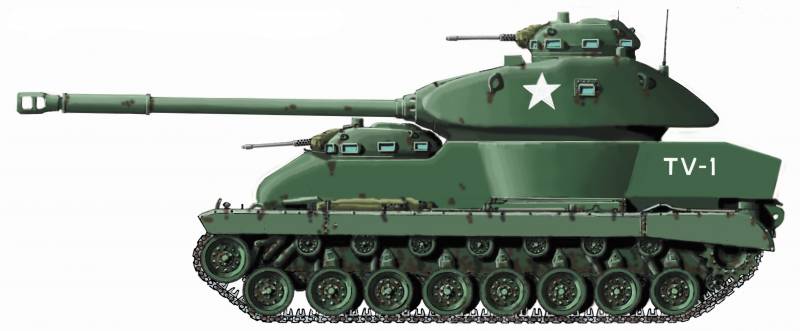
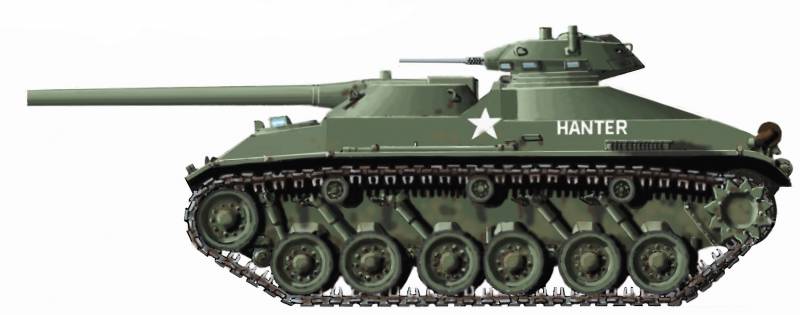
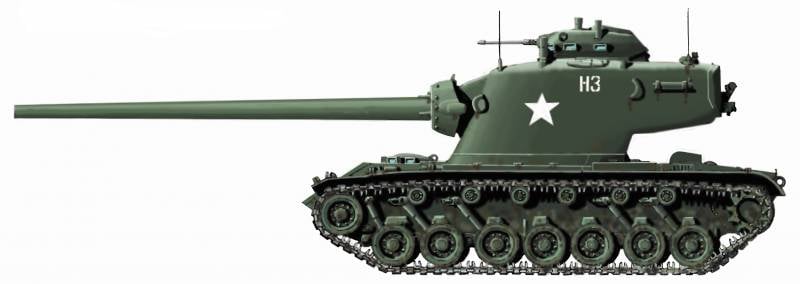
Information